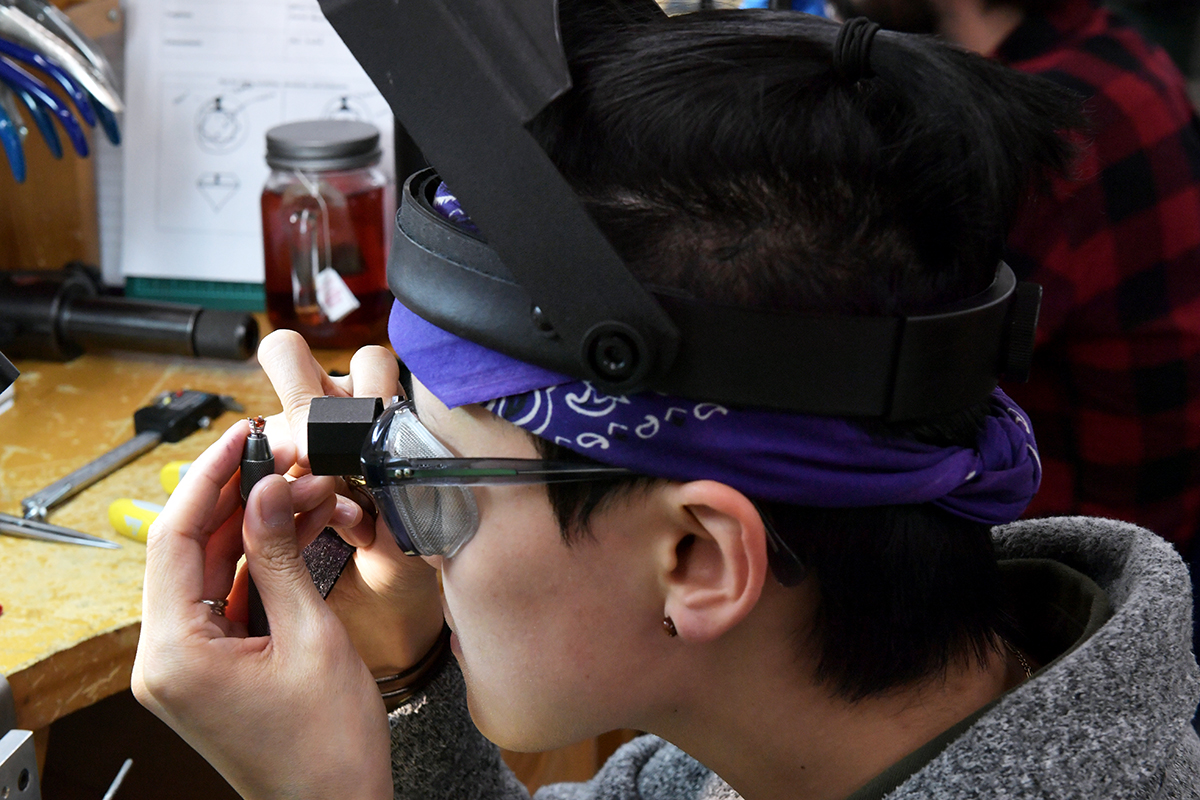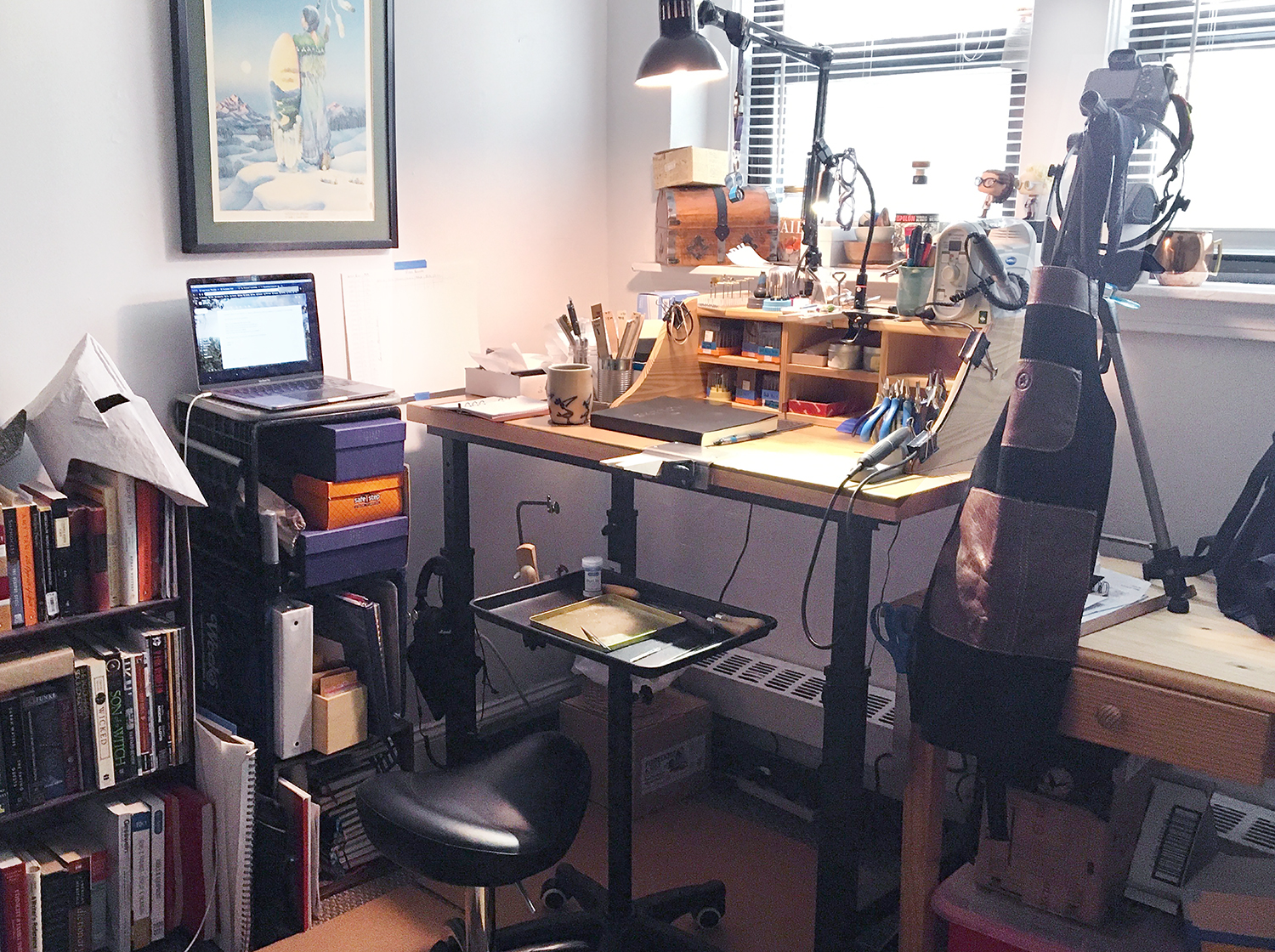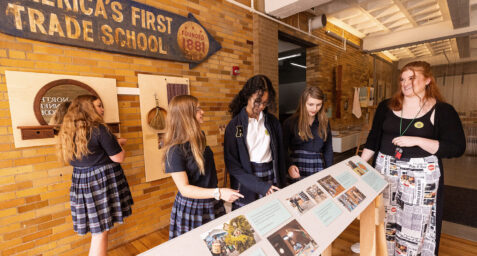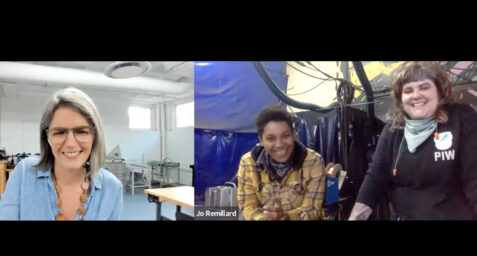In the Making: Willow Coronella
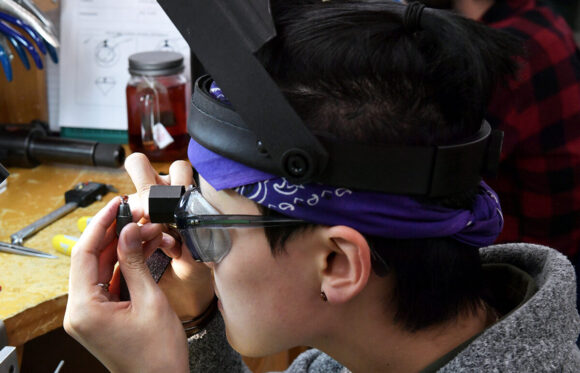
It’s a really satisfying thing to do, to build things.
Willow Coronella JM ’20
Willow was working in logistics when a friend shared their experience of training at NBSS. Recalling her fondness for making art with her hands as an undergrad, and dissatisfied with sitting at a computer in her then-current job, Willow wanted to find something that she knew would lead to a satisfying career. On a whim she applied to NBSS, and almost two years later she’s nearly ready to graduate from the Jewelry Making & Repair program—a timeline somewhat derailed by the pandemic, unfortunately.
But Willow remains inspired by jewelry making, focused on the process, and continues to follow the highest standards in her training. When reflecting on the type of person who studies at NBSS, Willow shares, “People who really like to dig into something and want to make sure they turn out something of quality.” There’s no doubt Willow’s instructors and peers would liken her to that as well.
For someone who has grown used to the equipment in the NBSS Jewelry Making & Repair program, it could have been a challenge to work from home. Ever prepared and creative, Willow set up a workable space in her bedroom and continues to make progress in her training. In this interview soon after our building closed in mid-March, we talk about her work, and how she’s enthusiastic about not only making, but academia and research too.
Below is an excerpt from our conversation, edited for space and clarity.
Kristen Odle: Let me start us off with a very basic question. How are you holding up during this strange time?
Willow Coronella: I am doing pretty okay considering how nuts the world is right now. I’m lucky in that I’m in a safe place, my family’s all safe, and everybody’s healthy so far.
KO: Good. I know Ann [Cahoon, Jewelry Making & Repair Department Head] has kept you connected and busy, and that you’re doing online Zoom classes with her. But are you actually constructing any jewelry at home?
WC: We’re definitely leaning into the academic parts of jewelry making that we honestly wouldn’t be able to get in the normal program. Which has been really great because we can really dig into the processes.
But yeah, we’re really lucky in that our work is small and a lot of our tools are pretty small too. So we were able to bring a lot of that home. To some extent we’re a little bit hindered in terms of safety, being able to do every single type of process. We’re not able to solder in our homes, necessarily without any good ventilation, and polishing as well. We have to rely on our good engineering brains at this point to try to work around those to see what kind of products we can turn out.
KO: Is that something that you have learned in the jewelry making program with Ann, is to lean into your engineering mind? Is that a big part of your work?
WC: Definitely, and it’s coming more and more in handy now that we fully can understand every process. So in terms of jewelry, one of the biggest things is that we oftentimes need torches to anneal material or soften up material and make it more moveable. Since we don’t have that in our homes, we aren’t able to do that safely. We kind of have to re-engineer how we’re going to build pieces so that they don’t harden up as we work on them and make it more difficult for us to move it, and really, really thinking about every single process before we do it makes that possible, I guess.
KO: What is some new technique that you’ve had to learn given that you can’t do in your own home?
WC: It’s less about new techniques and more thinking back to really basics, going back down to did I make a really good plan? Did I execute a layout cleanly enough so that when I go and do forming, I don’t have to work it back and forth a ton? So it’s more working with the very basic information that’s the basis for everything that we do.
KO: Is that a jewelry bench right there or is it something else modified?
WC: So this is actually not a jewelry bench in and of itself, but this is the work service that I was actually building before this all kind of came down. It’s just a regular work table that oftentimes you’ll find in garages. I wanted something that I could raise and lower. This is adjustable, and what you can see here is a dovetail plate so I can use one of our very common and very, very important pieces of equipment…
KO: A bench pin!
WC: Pins, yeah! So I’m able to thankfully have a place to work.
KO: That’s great. How much of your time these days is spent online with the rest of the class and how much is actually hands on making?
WC: Right, so we spend at least an hour every day doing a big class get together, which is really nice. Every nine o’clock we’re all in Zoom and we’re all able to talk to each other and catch up, and specifically talk about a lot of the academic and research stuff we’re working on. I would say outside of that we do have a lot of independent work.
KO: What exactly are you researching?
WC: So we’re really digging into the technical nitty-gritty. We’re reading Santa Fe Symposium papers on very specific topics. We’ve covered things from casting to fire assay. Also, a lot of learning how to price our work once it’s completed, to make sure that we’re not pricing ourselves out of the market, but also being competitive.
KO: That’s great. There are some students who just want to get in and make, and some that embrace the academic angle, doing sort of background work on your trade. What’s your take on that? Are you appreciative that you have this rare opportunity to absorb info and research?
WC: I’ve really appreciated having the time to dig into the academic stuff, because there’s sometimes a disconnect for me between what I’m physically doing and what is happening on a microscopic level. Being able to connect those dots has been really helpful to understanding why I should or shouldn’t do things a certain way.
I will say I am missing some of the hand skills. I miss soldering especially, because that’s definitely a perishable skill.
KO: Wait, what’s a perishable skill?
WC: A lot of the skills, because they’re such a muscle memory thing, you’ll forget if you stop doing them after a certain amount of time. You start forgetting what things feel like… You start forgetting when things look like they’ve gotten too hot to solder and you’ve torched things too far. You can’t file a straight line or you can’t file flat and square because you haven’t done it in a while.
These are all things that certainly you can unlearn, maybe a little less quickly than you can learn it, but it’s possible.
KO: Ahh, got it. What’s been your favorite experience so far in your program?
WC: I don’t think it’s so much of an individual favorite thing so much as seeing the progress over time. I think it’s really empowering to see how much you can achieve and how much you can learn in a short time. And when you’re so focused on one set of skills or one topic, just how good you can become at something that you didn’t know anything about, and had no idea how to do, and couldn’t do.
We struggled for the first couple of months just filing flat, straight, and square, and then you find out by year two that you’re setting these very fragile crystals that could shatter in a minute and yet somehow you manage to make this really durable, amazing piece.
KO: I’m curious: in your experience, can you describe the kind of person you think decides to train at NBSS?
WC: I think there’s a range of reasons people come to this school. For the majority I would say it’s people who really like to dig into something and want to make sure that they’re turning out something of quality. They really want to make sure that that quality stamp is understood, and that their work is appreciated, and that they are willing to put in the work. So kind of a two-way street – and I think that that commitment to a set of really strong standards is kind of what I think drives a lot of people that come here, as well as just having the physical kind of feedback of doing something with your hands. Again, it’s a really satisfying thing to do, to build things.
KO: Yes. What are you most looking forward to, getting back into the building?
WC: In all honesty, I think it’s going to be having other people, other jewelers around me who I can bounce things off of. It’s kind of funny working in your own little bubble. Having feedback and having other people to share your successes and failures with is a really important piece that I kind of miss.
I think we don’t notice it until it’s not there anymore, and this has certainly been one of those experiences that we’re not going to forget soon.
KO: So true. Do you have anything else you want to share with the community about your experience?
WC: I mean I think we are definitely all in the same kind of boat and just keep creating, I guess. We all can do it in some small way. You see people cooking and knitting, which is really great, and that’s what’s probably going to get us through… Just keep making stuff.
Next up: Take a tour of Willow’s home bench here.
“In the Making” is a series of video interviews with members of our community where we get insight to their lives and work. Learn more about the conversations, and view a full list of interviews on the series homepage here.
